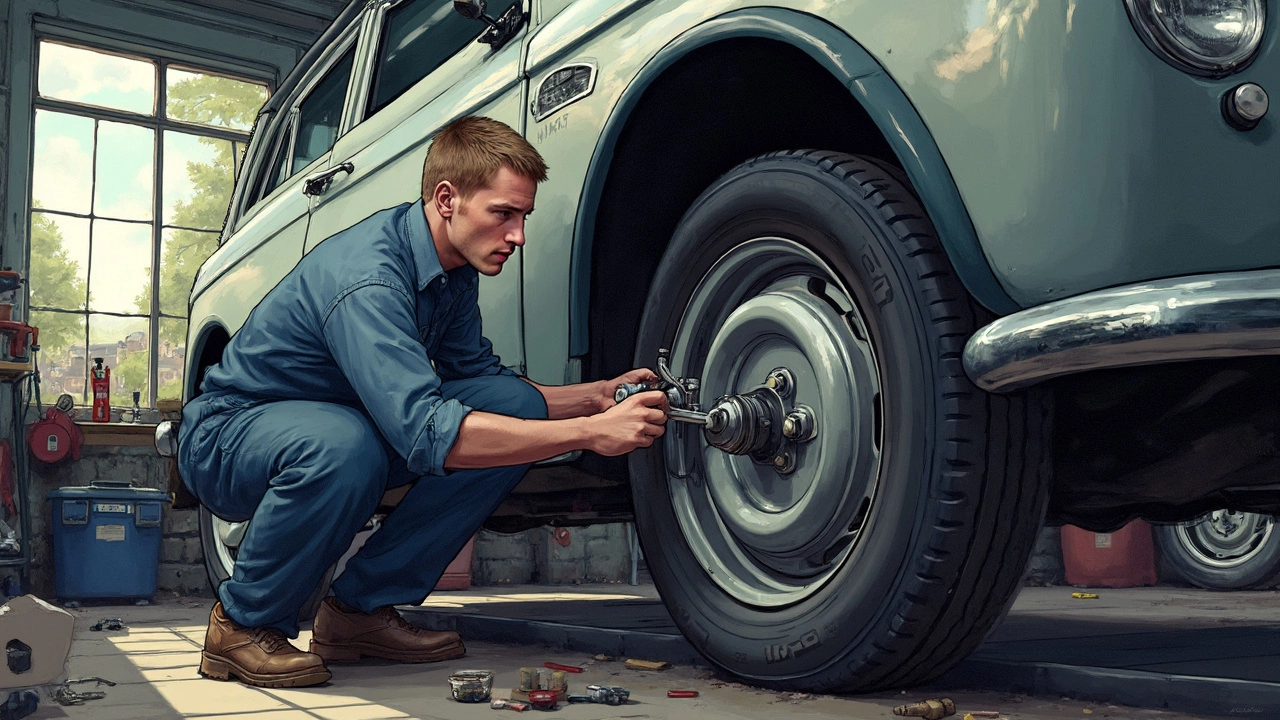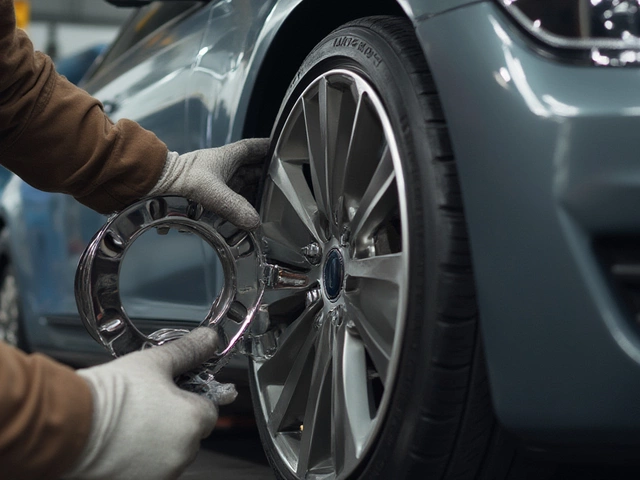Ever wondered how wheel spacers affect your car's speed? Well, you're not alone. A lot of us gearheads have toyed with the idea of using spacers to get that aggressive wheel stance, but there's always that lingering question about how it really affects performance, especially when it comes to speed. So, let’s break it down.
Wheel spacers are essentially discs you place between your vehicle's wheel and hub, allowing you to push the wheels out further for various benefits. They’re popular for giving cars a wider track and a cool aesthetic look, not to mention potential tweaks in handling. But keep in mind, these spacers bring changes to vehicle dynamics that can influence how fast and safely you can drive.
But what's the catch? The effects on speed aren’t straightforward. There’s no magic number like 50, 100, or 150 km/h that spacers let you hit safely. It’s about understanding how they alter your ride. Weight distribution, handling, and even tire wear can change, all of which matter if you’re pushing your speed limits.
- Understanding Wheel Spacers
- Impact on Vehicle Dynamics
- Legal Considerations
- Installation Tips
- Safety Precautions
- Balancing Performance and Safety
Understanding Wheel Spacers
So, what exactly are wheel spacers? In simple terms, they're components designed to fit over a vehicle's holding bracket to create extra space between the wheel and the hub assembly. Some folks use them to mount bigger tires, improve the vehicle's aesthetic appeal, or enhance handling performance.
Why bother with them, though? Well, spacers can make a world of difference if you're aiming for that wider track. A wider stance can contribute to better stability, especially when you're cornering or taking on those tricky terrains. For off-road enthusiasts, this can be a game-changer.
Types and Sizes
Spacers come in various types and sizes. You can get them in thicknesses ranging from 5mm to several centimeters, depending on your needs. The 'slip-on' type is most common for modest requirements, while 'bolt-on' spacers are popular for more significant modifications, usually over 20mm.
Materials Used
Typically, spacers are made from aluminum or steel. Aluminum is lightweight, which means it doesn’t add unnecessary weight to your ride. Steel, on the other hand, is incredibly durable. However, keep an eye on possible rust issues over time.
Installation
Installing wheel spacers isn't rocket science, but it demands precision. You simply mount the spacer between the hub and the wheel using the studs or bolts. Check for proper alignment and even fitment across all wheels. If you're not confident, a professional mechanic can make sure everything is up to par.
And, just like any mod, there are pros and cons. Spacers might strain other parts like bearings and suspension if not used wisely. So, balance is key!
Impact on Vehicle Dynamics
Slapping on some wheel spacers changes how your car feels on the road. But how exactly? Here's the scoop.
When you install spacers, you're altering the track width of your vehicle. This knock-on effect simplifies to one core thing: a wider stance that can improve cornering stability. You might feel your car hugging turns with a bit more grit.
Handling and Stability
Probably the biggest reason folks reach for wheel spacers is to make their ride more stable when navigating those tight hairpin turns. The wider track means you get an enhanced grip potential. But don't get too comfortable; if the spacers aren't installed well or are too wide, you could tip the scales towards worse rather than better handling.
"Spacers can improve vehicle dynamics by lowering the center of gravity and increasing track width. Although the improvement is marginal, it's noticeable at higher speeds," says Tom Ridley, a veteran automotive engineer.
The Steering Feel
With spacers, the steering can feel different—sometimes heavier. This is because the pivot point of the wheel has shifted thanks to the new setup. Some enjoy the extra heft because it makes the steering feel more precise. Others might not like it because it demands a bit more muscle on those longer drives.
Potential Downsides
Now, love them or hate them, spacers aren’t everyone's cup of tea. One issue? They can mess with the car's alignment and increase tire wear if not set up correctly. This can lead to vibrations at higher speeds—a far cry from what anyone wants.
Also, if the increase in track width is too much, this could affect the suspension and tire contact patch, reducing the efficiency of your tires.
So, if you're thinking about installing spacers, keep in mind those effects on dynamics. A set-and-forget mentality won't work, because regular checks are key for ensuring they don’t mess with your ride quality. Balance is crucial, and knowing these impacts can help keep things in check.
Legal Considerations
Before slapping on those wheel spacers, it's wise to check out the legal stuff. In Australia, like many places around the world, the laws around vehicle modifications vary quite a bit. Crazy, right? But skipping due diligence can lead to fines or even having your insurance voided.
Regulations and Compliance
First off, always verify the modifications are road-legal according to your state's regulations. In some states, modifications like spacer wheels could require an engineering certificate to prove they’re safe. It’s not just a quick swap and drive.
For instance, the Australian Design Rules (ADRs) set out standards that every modification must meet. This means your vehicle’s performance and handling shouldn't be negatively affected by the spacers. It might sound like a hoop to jump through, but it ensures your safety and others' on the road.
Inspections and Certifications
Another thing to keep an eye on is how often you might need to have your car inspected if you do use wheel spacers. Sometimes, periodic checks are recommended or even mandated, especially if you notice changes in vehicle handling or unusual tire wear.
| State | Certification Required | Periodic Inspection |
|---|---|---|
| Victoria | Yes | Annually |
| New South Wales | Yes | Annually or biannually |
| Queensland | No, unless stated by an engineer | Biannually |
Insurance Implications
Got insurance? Altering your vehicle with spacer wheels without notifying your insurer might cause you headaches later. Some policies can void coverage if mods aren't disclosed, especially if they directly influence the vehicle's performance or safety levels.
At the end of the day, staying informed and compliant with legal requirements not only keeps you safe but also gives you peace of mind. So, do your homework before making any mods!

Installation Tips
Thinking of popping some wheel spacers onto your ride? Awesome choice for that mean look and a wider track, but it's key to get the install right. Here’s a straightforward guide to make sure everything goes smoothly.
Gather the Right Tools
Before you start, make sure you've got all the essential tools handy. You’ll need a jack and stands, a torque wrench, and of course, your shiny new spacers. Double-check that the spacers match your car’s bolt pattern!
Step-by-Step Installation
- Lift the Car Safely: Use a jack to lift your vehicle and secure it with proper stands. Safety first, always!
- Remove the Wheels: Loosen and remove the lug nuts, and take off the wheels. It's like a warm-up to the main event.
- Clean the Hub Surface: Make sure the hub surfaces are spotless. A clean surface ensures a snug fit for your wheel spacers.
- Install the Spacers: Align the spacers with the hub and bolt them on. Tighten them using the torque specs provided by the spacer manufacturer. Do not guess here!
- Reattach the Wheels: Put the wheels back on, and tighten the lug nuts. Don’t forget to use the torque wrench for this part too.
- Lower the Vehicle: Once everything's secure, gently lower the car back to the ground and double-check all the bolts.
Check Everything
Once installed, it's not a bad idea to drive around the block and then re-check the tightness of everything. It helps catch anything you might’ve missed. Also, pay attention to any new noises or vibrations—you want a smooth ride.
Installing wheel spacers can be pretty straightforward, but patience and attention to detail are your best allies here. It’s all about ensuring you get the look and performance without compromising safety.
Safety Precautions
Let's talk safety because when it comes to wheel spacers, ignoring it is a big no-no. First off, always make sure you're using the right size and type of wheel spacer for your car. Choosing the wrong one can throw off your vehicle's handling, and nobody wants that kind of surprise when hitting the road.
One major thing to remember is to get spacers that are hub-centric. Why, you ask? Because they fit snugly against the hub and keep your wheels properly aligned, reducing the risk of any nasty vibrations while driving. Trust me, you don’t want your car rattling like a snake.
Regular Inspections
You’ve installed those spacers, now what? Don't forget regular check-ups! Every so often, inspect your wheel spacers and the bolts to make sure everything is tightened properly. Loose bolts are a recipe for disaster and can lead to wheels wobbling, or worse, coming off entirely.
Tire and Wheel Care
- Balance your wheels: With spacers, the distribution might change, so getting your wheels balanced is crucial.
- Monitor tire wear: Uneven wear can hint at larger issues.
- Check tire pressure: Make sure you’re maintaining optimal levels for safe driving.
Having wheel spacers doesn’t mean carefree driving. It means taking extra steps in your car’s maintenance routine for a smoother and safer ride.
There's more to think about, like getting professional advice when buying and installing these wheel spacers. Professionals have the tools and the know-how. Don't be shy to ask them about speed ratings and any other questions hanging around in your head.
Final Thought
Safety with wheel spacers comes down to common sense and diligence. Be smart about it, and you'll enjoy a mix of performance gains and peace of mind. Your car, and probably your fellow road users, will thank you for it.
Balancing Performance and Safety
When you're stepping into the world of wheel spacers, the goal isn't just about looking good on the road; it's about finding that sweet spot between performance and safety. It's not as tricky as it sounds, but it does require some thought.
First things first, what exactly are you aiming for? If it's solely about aesthetics, remember that changing how your ride looks can impact how it handles. Spacers can adjust how close your wheels are to the suspension or body, which can improve stability but might also throw off your alignment if not done right.
Understanding the Trade-Off
When you add wheel spacers, you're effectively changing the geometry of your car's suspension. This means potentially more grip if done correctly, as the wider track can give your tires a better stance. But watch out—going too wide can result in increased tire wear and stress on suspension parts, which isn't something you want if you're chasing top speeds.
The trick is to choose a spacer size that aligns with your driving habits and the vehicle's intended use. Are you hitting the track or just cruising around town? A 5 mm to 20 mm spacer is typically ideal for most street uses, balancing looks and safety without pushing too hard on components.
Legal and Safety Aspects
Legislation varies, but it's crucial to ensure whatever you do remains street-legal. Too much protrusion can not only make you a target for tickets but also compromise safety in other drivers' eyes. It's always wise to check the guidelines in your region regarding spacer use.
And then there's the installation aspect. Incorrectly fitted spacers can lead to wheel wobble (and nobody wants that at high speeds). A reliable bolt pattern match and quality material choice—think aluminum or steel—go a long way in keeping things safe. Never compromise on the lug nuts' quality; they bear a lot of pressure.
Pro Tips for Optimal Use
- Regularly check your spacers and surrounding parts for signs of wear or damage.
- Consider upgrading to performance tires alongside spacers for enhanced grip.
- Always maintain your wheels' balancing and alignment after installing spacers to extend tire life and ensure smooth driving.
In summary, it's all about a balanced approach—you're aiming for a more engaging drive and killer looks without giving up safety or shedding away from the law. With the right size, quality installation, and routine checks, your spacer-enhanced vehicle can remain the perfect blend of style and stability.




